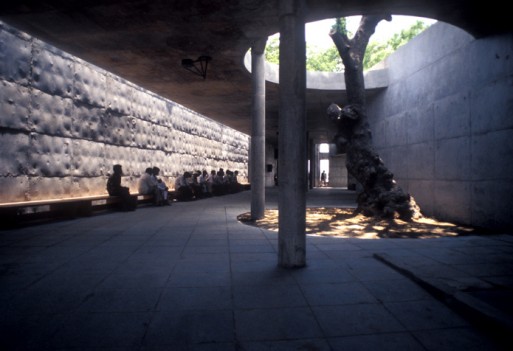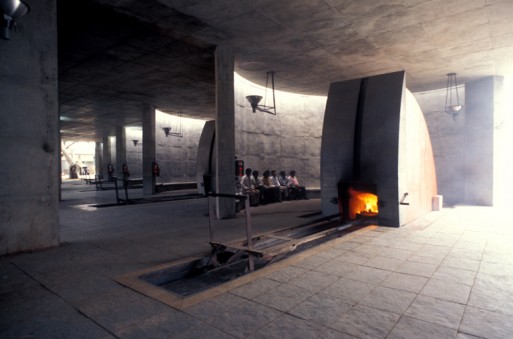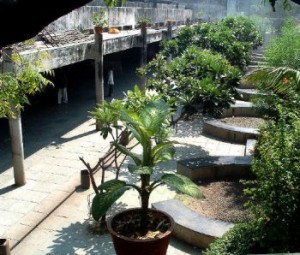We are wrapping up our focus on India today, in honor of Gandhi’s birthday and the International Day of Nonviolence, with a look at the beautiful Ashwinlkumar Crematorium in Surat, India. The architecture of this structure pays respect to its purpose and helps give it a quiet dignity. It stands on the bank of the River Tapti, the surrounding area cleared of the existing ancient structures to allow the renovated crematorium to stand proud in its beauty.

The building is based on the basic crematorium structure – the pavilion – with a focus on facilitating mourning and taking care of the dead.
The building is almost hidden behind high concrete walls and trees, and a modest entrance and surroundings. Around the crematorium – the oldest in the city of Surat – are old factories and huts. Once inside, however, the building reveals its grandeur, with a large hall that houses five gas-fired furnaces and opens to a view of the river. As a body is cremated, people gather throughout the hall and along the river to thoughtfully mourn and honor the deceased, and the hall is scattered with the remnants of the life-honoring rituals that are performed before a body is cremated here.

The crematorium that exists today is a renovation of the original building. In 1994, Surat was hit with a severe flooding of the River Tapti, which caused an unidentified epidemic, followed by communal riots in 1983. The industrial town became known and criticized for its substandard conditions, and citizens eventually called for a reconstruction effort. The major overhaul of the crematorium was a result of this spirit of reformation, an effort to create a more modern, efficient, and hygenic crematorium.
Once the citizens of Surat had decided to renovate the crematorium, a national design competition was held to choose the architect. Of thirty entrants, Gurjit Singh Matharoo was the architect whose simple and straightforward design was chosen for the renovation. The building was completed in 2000.
 The Ashwinlkumar Crematorium embodies the spirit of embracing and celebrating life, of rebirth, of creating life from death. When the decision was made to renovate the old building, it sat among squalor, becoming part of the filth. Surat’s citizens chose to save this historical building from its slow demise by breathing new life into it. Through this sentiment, a simplistic beauty was created – one that exists as the threshold between death and new life.
The Ashwinlkumar Crematorium embodies the spirit of embracing and celebrating life, of rebirth, of creating life from death. When the decision was made to renovate the old building, it sat among squalor, becoming part of the filth. Surat’s citizens chose to save this historical building from its slow demise by breathing new life into it. Through this sentiment, a simplistic beauty was created – one that exists as the threshold between death and new life.
Hindu Magazine
The Architecture League of New York

 Creating New Life from Death
Creating New Life from Death


 John Mulaney’s “Funeral Planning” on Netflix: No Real Plan
John Mulaney’s “Funeral Planning” on Netflix: No Real Plan

 Composting Bodies Is Now Legal in a Dozen States
Composting Bodies Is Now Legal in a Dozen States














